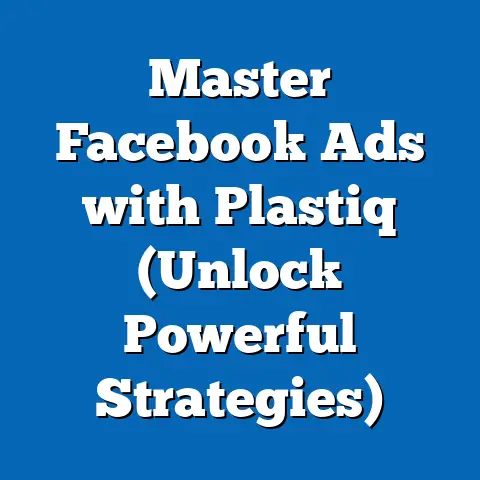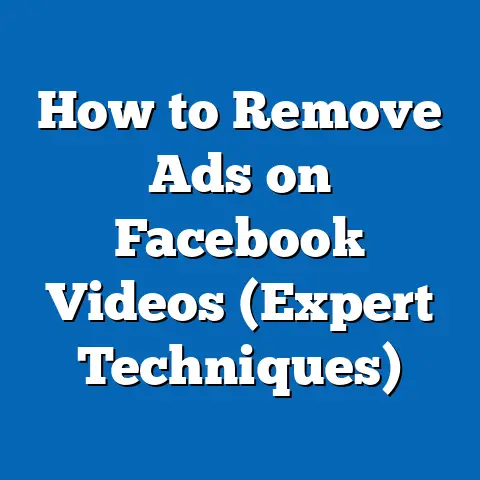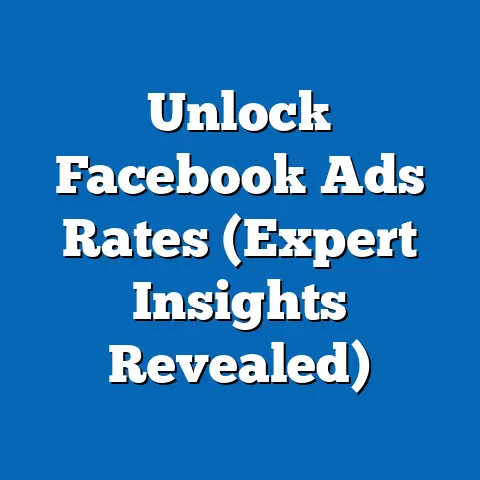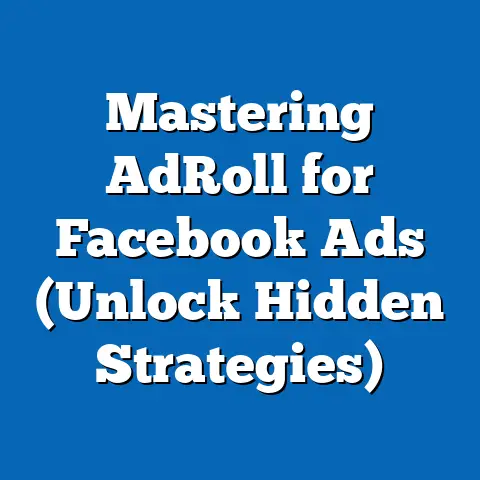Transform Facebook Ads Campaign for Maximum Impact (Pro Tips)
Facebook advertising. It’s a landscape that’s constantly shifting, a battlefield where businesses of all sizes are vying for attention. But here’s the thing: despite the noise and the competition, Facebook Ads remain one of the most powerful and cost-effective tools I know for reaching targeted audiences and driving real results.
I’ve seen it firsthand. From helping local boutiques boost their online sales to guiding tech startups in acquiring thousands of new users, Facebook Ads have consistently delivered impressive returns. But the key, as I’ve learned over years of experience, isn’t just about throwing money at the platform. It’s about strategically transforming your campaigns to maximize their impact.
Recent studies show that businesses can achieve an average ROI of $8.71 for every $1 spent on Facebook Ads. That’s a compelling figure, but it’s only achievable with the right approach. I’m going to dive into the nitty-gritty of transforming your Facebook Ads campaigns. From understanding your audience to crafting compelling creative and leveraging advanced targeting options, I’ll share pro tips that can help you unlock the full potential of this powerful advertising platform.
Understanding Your Audience: The Foundation of Success
Before you even think about crafting an ad, you need to know who you’re talking to. I always tell my clients, “You wouldn’t walk into a room and start shouting random messages, would you? So why do that with your ads?” Understanding your audience is the bedrock of any successful Facebook Ads campaign.
Audience Segmentation: Beyond the Basics
Facebook offers a wealth of tools for segmenting your audience. Demographics (age, gender, location), interests (hobbies, passions, favorite brands), and behaviors (purchase history, online activity) are just the starting point. I encourage you to dig deeper.
Pro Tip: Unleash Facebook Audience Insights
Facebook Audience Insights is a goldmine of information. It allows you to analyze the characteristics of your target audience in granular detail. You can discover:
- Demographics: Age, gender, education level, relationship status, job titles.
- Interests: Top pages they like, categories they’re interested in.
- Lifestyle: Their preferred activities, media consumption habits, and technology usage.
- Purchase Behavior: Their online shopping habits, purchase frequency, and spending patterns.
I remember working with a local bakery that wanted to promote their new line of vegan cupcakes. Initially, they were targeting a broad “vegetarian” audience. But by using Audience Insights, we discovered that their ideal customers were actually young, urban professionals interested in fitness, healthy eating, and sustainable living. Armed with this knowledge, we refined our targeting and saw a significant increase in ad engagement and sales.
Creating Buyer Personas: Giving Your Audience a Face
Buyer personas are fictional representations of your ideal customers. They go beyond basic demographics and delve into the motivations, goals, and challenges of your target audience.
Here’s how to create effective buyer personas:
- Conduct Research: Interview existing customers, analyze customer data, and use tools like Facebook Audience Insights to gather information.
- Identify Key Characteristics: Identify common traits, behaviors, and motivations among your target audience.
- Give Your Persona a Name and Story: Bring your persona to life by giving them a name, a job, a family, and a story.
- Define Their Goals and Challenges: What are they trying to achieve? What obstacles are they facing?
- Tailor Your Messaging: Use your persona to guide your ad creative and messaging. Speak directly to their needs and aspirations.
Takeaway: Understanding your audience is the foundation of a successful Facebook Ads campaign. Use Facebook Audience Insights and create detailed buyer personas to gain a deeper understanding of your target audience and tailor your messaging accordingly.
Crafting Compelling Ad Creative: Capturing Attention in a Noisy World
Once you know who you’re talking to, you need to create ads that grab their attention and resonate with their needs. In today’s crowded digital landscape, that’s no easy feat. I always say that your ad creative is your first impression, and you only get one chance to make it count.
The Elements of Effective Ad Creative
Effective ad creative consists of three key elements:
- Visuals: Eye-catching images, videos, or carousel ads that capture attention and convey your message.
- Copywriting: Compelling text that speaks directly to your target audience, highlighting the benefits of your product or service.
- Calls to Action (CTAs): Clear and concise prompts that encourage users to take the desired action (e.g., “Shop Now,” “Learn More,” “Sign Up”).
Designing Eye-Catching Visuals
Visuals are the first thing people see when they encounter your ad. They need to be high-quality, relevant, and attention-grabbing.
Here are some tips for designing effective visuals:
- Use High-Quality Images and Videos: Avoid blurry or pixelated images. Invest in professional photography or video production if necessary.
- Choose Relevant Visuals: Your visuals should be relevant to your product or service and resonate with your target audience.
- Use Bright Colors and Bold Designs: Stand out from the crowd with eye-catching colors and bold designs.
- Showcase Your Product in Action: Demonstrate how your product solves a problem or improves people’s lives.
- Use Carousel Ads to Tell a Story: Carousel ads allow you to showcase multiple images or videos in a single ad unit. Use them to tell a story or highlight different features of your product.
I once worked with a clothing brand that was struggling to generate sales with their Facebook Ads. Their visuals were generic and uninspired. We revamped their ad creative by using high-quality images of real people wearing their clothes in everyday settings. We also created carousel ads that showcased different outfits and styling tips. As a result, their ad engagement and sales skyrocketed.
A/B Testing Your Ad Copy
Your ad copy is just as important as your visuals. It needs to be clear, concise, and persuasive. The best way to determine what resonates with your audience is to A/B test different ad copies.
Here’s how to A/B test your ad copy:
- Create Multiple Versions of Your Ad Copy: Write several different versions of your ad copy, each with a slightly different message or angle.
- Use Facebook’s A/B Testing Tool: Facebook Ads Manager has a built-in A/B testing tool that allows you to test different ad copies against each other.
- Track Your Results: Monitor the performance of each ad copy and identify the one that generates the best results (e.g., highest click-through rate, lowest cost per conversion).
- Use the Winning Ad Copy: Use the winning ad copy in your future campaigns.
Example of Successful Ad Copy
Here’s an example of successful ad copy that has driven high engagement and conversion rates:
- Headline: “Tired of Feeling Tired? Get Your Energy Back with [Product Name]”
- Body Copy: “Do you struggle with fatigue, low energy, and brain fog? [Product Name] is a natural supplement that can help you boost your energy levels, improve your focus, and feel your best. Try it risk-free today!”
- Call to Action: “Shop Now”
Takeaway: Crafting compelling ad creative is essential for capturing attention and driving results. Use high-quality visuals, write clear and concise ad copy, and A/B test different versions to determine what resonates best with your audience.
Utilizing Advanced Targeting Options: Reaching the Right People
I’ve stressed the importance of understanding your audience, but that’s only half the battle. You also need to make sure your ads are reaching the right people. Facebook offers a range of advanced targeting options that can help you laser-target your ideal customers.
Custom Audiences: Targeting Your Existing Customers
Custom Audiences allow you to target people who have already interacted with your business. You can create Custom Audiences based on:
- Customer List: Upload a list of your existing customers’ email addresses or phone numbers.
- Website Traffic: Target people who have visited your website.
- App Activity: Target people who have used your mobile app.
- Engagement on Facebook: Target people who have liked your page, watched your videos, or engaged with your posts.
Lookalike Audiences: Expanding Your Reach
Lookalike Audiences allow you to reach new people who are similar to your existing customers. Facebook analyzes the characteristics of your Custom Audience and finds other users who share those traits. This is a powerful way to expand your reach and find new customers who are likely to be interested in your product or service.
Detailed Targeting: Refining Your Audience
Detailed targeting allows you to target users based on their demographics, interests, and behaviors. This is a great way to refine your audience and make sure you’re reaching the most relevant people.
Case Study: How a Brand Used Advanced Targeting to Enhance Campaign Performance
A fitness apparel brand wanted to promote their new line of yoga pants. They created a Custom Audience based on their existing customers who had purchased yoga pants in the past. They then created a Lookalike Audience based on that Custom Audience. Finally, they used detailed targeting to target users who were interested in yoga, fitness, and healthy living. As a result, their ad engagement and sales increased significantly.
Takeaway: Facebook’s advanced targeting options allow you to reach the right people with your ads. Use Custom Audiences, Lookalike Audiences, and detailed targeting to laser-target your ideal customers and maximize your campaign performance.
Optimizing Ad Placement and Budgeting: Making Every Dollar Count
Now that you’ve got your audience and creative sorted, it’s time to think about where your ads are appearing and how much you’re spending. I’ve seen many campaigns fail because of poor ad placement and inefficient budgeting. It’s like having a great product but putting it on the wrong shelf in the store.
Ad Placement: Choosing the Right Spot
Facebook offers a variety of ad placements, including:
- Facebook Feed: The main news feed where users see updates from friends, family, and businesses.
- Instagram Feed: The main feed where users see photos and videos from accounts they follow.
- Facebook Stories: Short-form videos and images that disappear after 24 hours.
- Instagram Stories: Similar to Facebook Stories, but on Instagram.
- Facebook Marketplace: A platform where users can buy and sell items locally.
- Audience Network: A network of third-party websites and apps where Facebook ads can appear.
The best ad placement for your campaign depends on your objectives, target audience, and ad creative. For example, if you’re trying to drive brand awareness, Facebook Feed and Instagram Feed might be the best options. If you’re trying to generate leads, Facebook Lead Ads might be a better choice.
Budgeting: Setting the Right Spend
Facebook offers two main budgeting options:
- Daily Budget: The average amount you’re willing to spend each day.
- Lifetime Budget: The total amount you’re willing to spend over the entire duration of your campaign.
The right budget for your campaign depends on your goals, target audience, and ad creative. As a rule of thumb, I always recommend starting with a smaller budget and gradually increasing it as you see positive results.
Pro Tip: Monitor Ad Performance and Make Data-Driven Adjustments
The key to optimizing your ad placement and budgeting is to monitor your ad performance closely and make data-driven adjustments.
Here are some metrics to track:
- Impressions: The number of times your ad is shown.
- Reach: The number of unique people who see your ad.
- Click-Through Rate (CTR): The percentage of people who click on your ad.
- Cost Per Click (CPC): The average cost you pay for each click on your ad.
- Conversion Rate: The percentage of people who take the desired action after clicking on your ad (e.g., make a purchase, sign up for a newsletter).
- Cost Per Conversion: The average cost you pay for each conversion.
Takeaway: Optimizing your ad placement and budgeting is essential for maximizing your ROI. Choose the right placements for your campaign objectives, set a budget that aligns with your goals, and monitor your ad performance closely to make data-driven adjustments.
Analyzing Performance and Making Data-Driven Decisions: The Continuous Improvement Cycle
You’ve launched your campaign, you’re seeing some results, but the work doesn’t stop there. I always tell my clients that Facebook advertising is a continuous improvement cycle. You need to constantly analyze your performance, identify areas for improvement, and make data-driven decisions to optimize your campaigns.
Key Metrics to Track
I’ve already mentioned some key metrics to track, but let’s delve a little deeper.
- Click-Through Rate (CTR): A high CTR indicates that your ad is resonating with your audience. If your CTR is low, you may need to tweak your ad creative or targeting.
- Cost Per Click (CPC): A low CPC indicates that you’re getting good value for your money. If your CPC is high, you may need to adjust your bid strategy or improve your ad quality.
- Conversion Rate: A high conversion rate indicates that your ad is driving the desired action. If your conversion rate is low, you may need to improve your landing page or streamline your checkout process.
- Cost Per Conversion: A low cost per conversion indicates that you’re getting a good return on your investment. If your cost per conversion is high, you may need to optimize your ad creative, targeting, or landing page.
Using Facebook Ads Manager and Facebook Analytics
Facebook Ads Manager and Facebook Analytics are powerful tools that can help you gain insights into your campaign performance.
- Facebook Ads Manager: Allows you to track your ad performance in real-time, monitor your budget, and make adjustments to your campaigns.
- Facebook Analytics: Provides insights into your website traffic, app activity, and customer behavior.
Actionable Tips for Interpreting Data
Here are some actionable tips for interpreting data and making informed decisions:
- Compare Your Results to Benchmarks: Compare your results to industry benchmarks to see how you’re performing relative to your competitors.
- Look for Trends and Patterns: Identify trends and patterns in your data to understand what’s working and what’s not.
- Segment Your Data: Segment your data by demographics, interests, and behaviors to identify your most valuable customers.
- Test Different Strategies: Test different ad creative, targeting options, and bidding strategies to see what generates the best results.
Takeaway: Analyzing your performance and making data-driven decisions is essential for optimizing your Facebook Ads campaigns. Track key metrics, use Facebook Ads Manager and Facebook Analytics, and test different strategies to continuously improve your results.
Conclusion: Transforming Your Facebook Ads for Lasting Impact
I’ve covered a lot of ground in this guide, from understanding your audience to analyzing your performance. But the key takeaway is this: transforming your Facebook Ads campaigns is an ongoing process that requires a strategic mindset, a willingness to experiment, and a commitment to data-driven decision-making.
By implementing the pro tips I’ve outlined in this article, I’m confident that you can enhance your advertising strategies and achieve better results. Remember to:
- Understand your audience deeply using Audience Insights and buyer personas.
- Craft compelling ad creative that captures attention and resonates with your target audience.
- Utilize advanced targeting options to reach the right people with your ads.
- Optimize your ad placement and budgeting to make every dollar count.
- Analyze your performance and make data-driven decisions to continuously improve your campaigns.
Now, I’d love to hear from you. What are your biggest challenges with Facebook Ads? What strategies have worked best for you? Share your experiences or ask questions about transforming your Facebook Ads campaigns in the comments below. I’m here to help you unlock the full potential of Facebook advertising and achieve your business goals.





